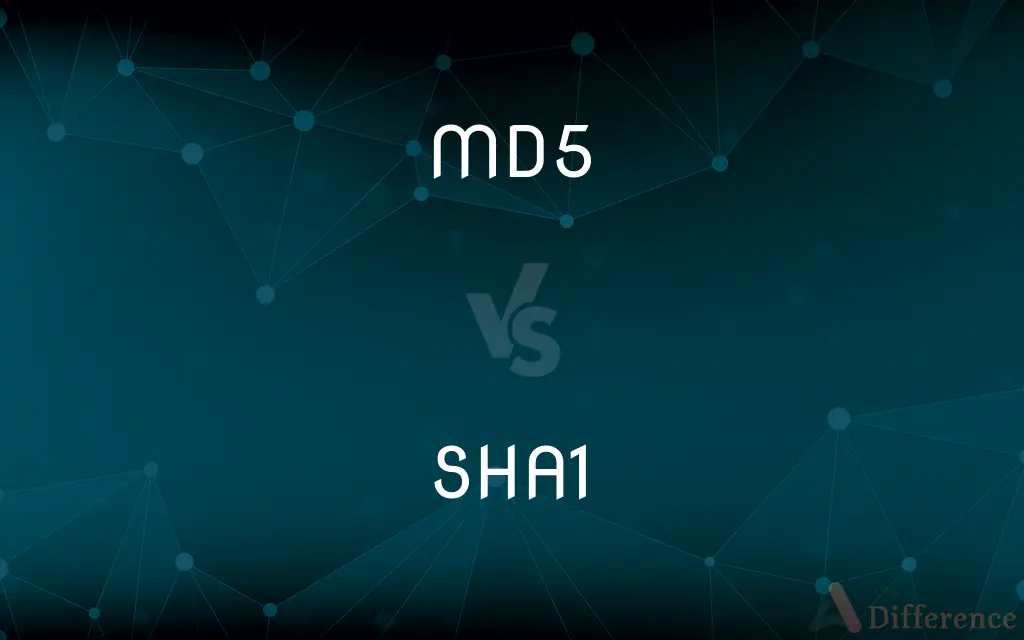MD5 vs. SHA1 — What's the Difference?
By Tayyaba Rehman — Published on January 3, 2024
MD5 and SHA1 are cryptographic hash functions; MD5 produces a 128-bit hash value, less secure and faster, while SHA1 generates a 160-bit hash, more secure but slower.

Difference Between MD5 and SHA1
Table of Contents
ADVERTISEMENT
Key Differences
MD5, or Message Digest Algorithm 5, is a widely-used cryptographic hash function that produces a 128-bit (16-byte) hash value. SHA1, or Secure Hash Algorithm 1, also a cryptographic hash function, generates a larger 160-bit (20-byte) hash value. MD5 was designed to be fast and efficient, whereas SHA1 was developed with a greater focus on security.
In terms of security, MD5 is considered less secure than SHA1. This is because MD5 is more vulnerable to collision attacks, where two different inputs produce the same hash output. SHA1, while stronger than MD5, has also been compromised to some extent, but it remains more secure than MD5.
MD5 was developed by Ronald Rivest in 1991, primarily for use in digital signature applications. SHA1 was developed by the National Security Agency (NSA) and published by the National Institute of Standards and Technology (NIST) in 1995, as part of the U.S. Government's Capstone project. Both were initially designed to provide data integrity.
The speed of hash generation is faster in MD5 compared to SHA1. This makes MD5 more suitable for non-security critical applications where speed is a priority. In contrast, SHA1, being slower but offering better security, is preferred in situations where hash security is paramount.
Adoption in the industry has seen a shift over the years. MD5 was once widely used in various applications, including SSL certificates, but its vulnerabilities have led to SHA1 becoming more prevalent. However, with advancements in cryptographic research, even SHA1 is being phased out in favor of more secure algorithms like SHA-256.
ADVERTISEMENT
Comparison Chart
Hash Value Size
128-bit (16 bytes)
160-bit (20 bytes)
Security
Less secure, vulnerable to collisions
More secure, but has known vulnerabilities
Speed
Faster hash computation
Slower in comparison to MD5
Date of Introduction
1991
1995
Typical Use
Non-critical security applications
Higher security requirements
Compare with Definitions
MD5
A cryptographic hash function with 128-bit hash values.
The website used MD5 to verify the integrity of downloaded files.
SHA1
Commonly used in SSL certificates and version control systems.
The SSL certificate for the website was generated using the SHA1 algorithm.
MD5
An algorithm for fast hash calculations.
MD5 quickly generated hash values for all the documents.
SHA1
A cryptographic hash function producing a 160-bit hash.
SHA1 was used to create a secure digital signature for the document.
MD5
Vulnerable to collision and preimage attacks.
Due to security concerns, the system migrated from MD5 to a more secure hash function.
SHA1
Slower than MD5 but provides better data integrity.
SHA1 was preferred for its robustness despite being slower than MD5.
MD5
Often used in checksums and fingerprints.
MD5 checksums helped verify the data integrity of the downloaded software.
SHA1
Developed for enhanced security over MD5.
Due to its improved security features, SHA1 replaced MD5 in many applications.
MD5
Designed for data integrity in digital communications.
MD5 ensured that the message was not altered during transmission.
SHA1
Prone to theoretical weaknesses but more secure than MD5.
SHA1, while not impervious to attacks, offered a higher level of security for encrypting data.
Common Curiosities
Is SHA1 more secure than MD5?
Yes, SHA1 is generally considered more secure than MD5.
Why is MD5 faster than SHA1?
MD5's simpler algorithm allows for quicker hash calculations.
What is the hash size of SHA1?
SHA1 produces a 160-bit (20-byte) hash.
What is the main use of MD5?
MD5 is primarily used for verifying data integrity and creating checksums.
Are MD5 hashes collision-resistant?
MD5 is not considered collision-resistant due to vulnerabilities.
What type of attacks is SHA1 vulnerable to?
SHA1 is vulnerable to collision and more advanced cryptographic attacks.
How does SHA1 improve over MD5 in terms of security?
SHA1 has a larger hash size and a more complex algorithm, enhancing security.
Why was MD5 popular in digital signatures?
MD5's speed and efficiency made it popular for digital signatures initially.
Has SHA1 been phased out for security reasons?
Yes, due to security concerns, SHA1 is being replaced by more secure algorithms.
Is SHA1 still used in SSL/TLS?
SHA1 has been largely replaced in SSL/TLS due to security weaknesses.
Can MD5 be used for secure encryption?
MD5 is not recommended for secure encryption due to its vulnerabilities.
Is SHA1 suitable for new cryptographic applications?
SHA1 is not recommended for new applications due to known vulnerabilities.
When was MD5 developed, and by whom?
MD5 was developed by Ronald Rivest in 1991.
What is a practical application of MD5?
MD5 is used in file verification to ensure data integrity.
What is a major drawback of using MD5 today?
The main drawback is its susceptibility to collision attacks.
Share Your Discovery

Previous Comparison
IntelliJ Ultimate vs. IntelliJ Community
Next Comparison
Warm Mist Humidifiers vs. Cool Mist HumidifiersAuthor Spotlight
Written by
Tayyaba RehmanTayyaba Rehman is a distinguished writer, currently serving as a primary contributor to askdifference.com. As a researcher in semantics and etymology, Tayyaba's passion for the complexity of languages and their distinctions has found a perfect home on the platform. Tayyaba delves into the intricacies of language, distinguishing between commonly confused words and phrases, thereby providing clarity for readers worldwide.












































